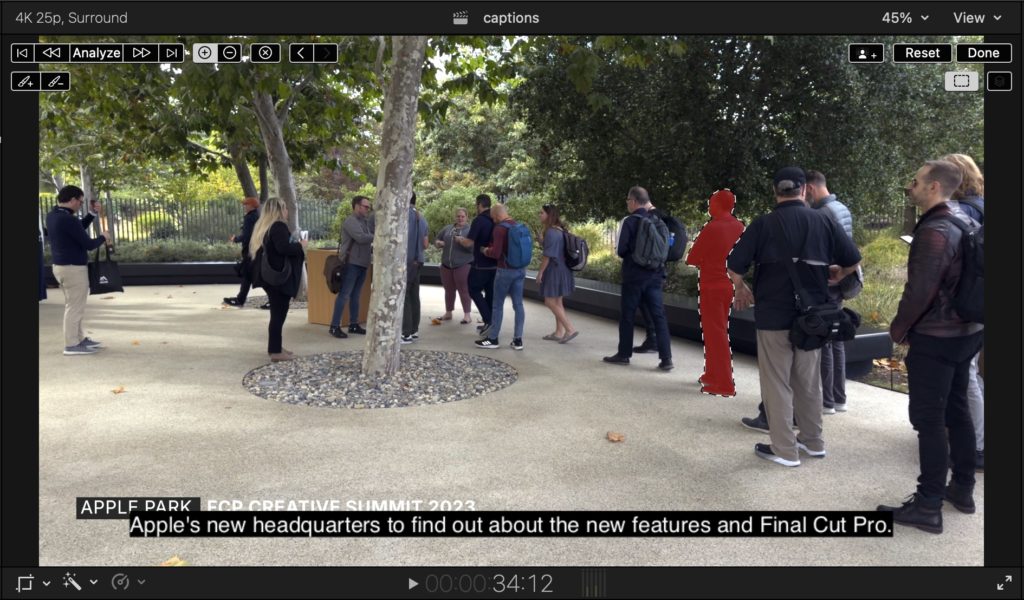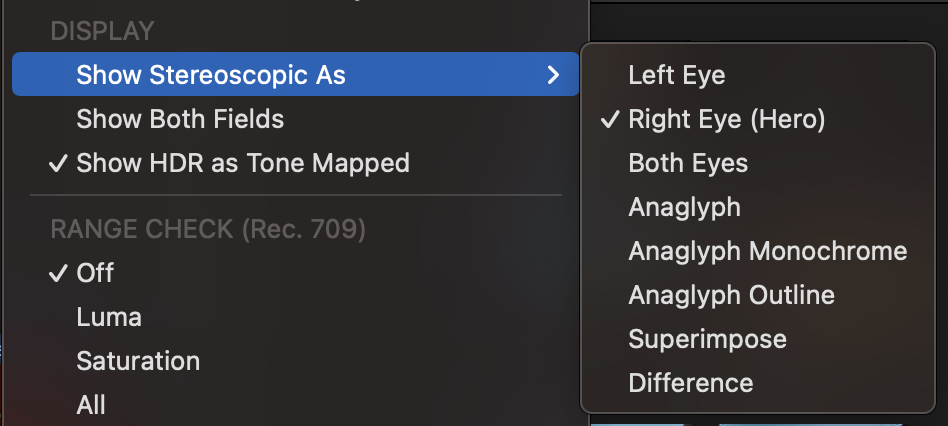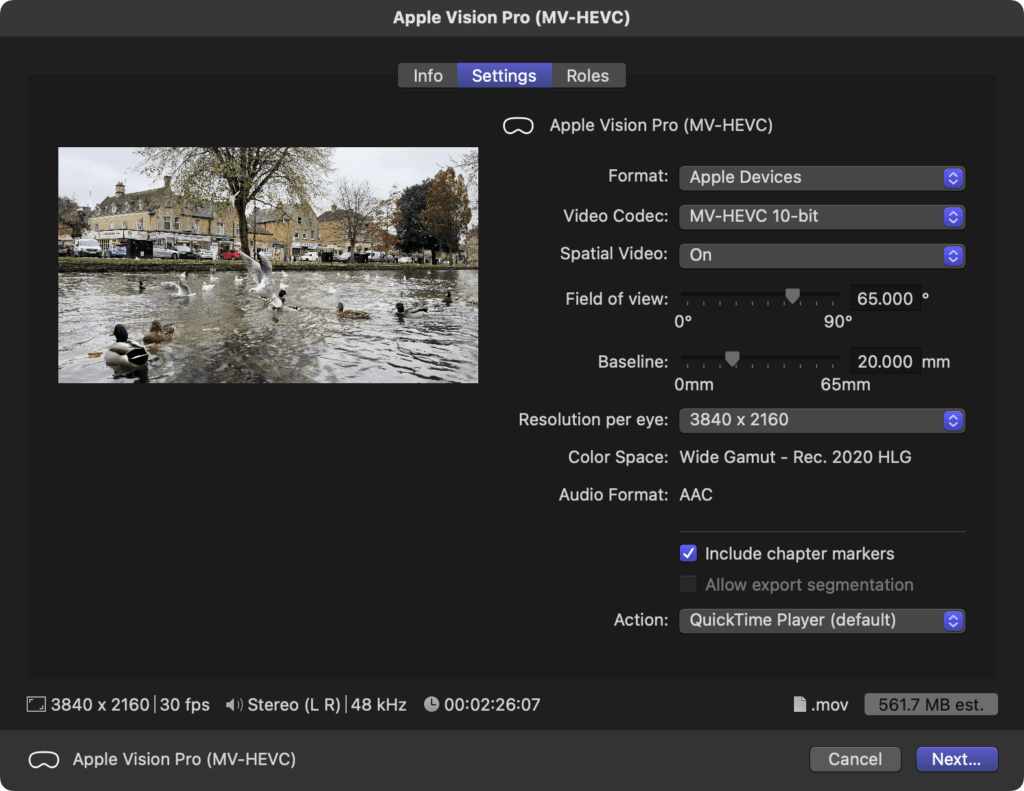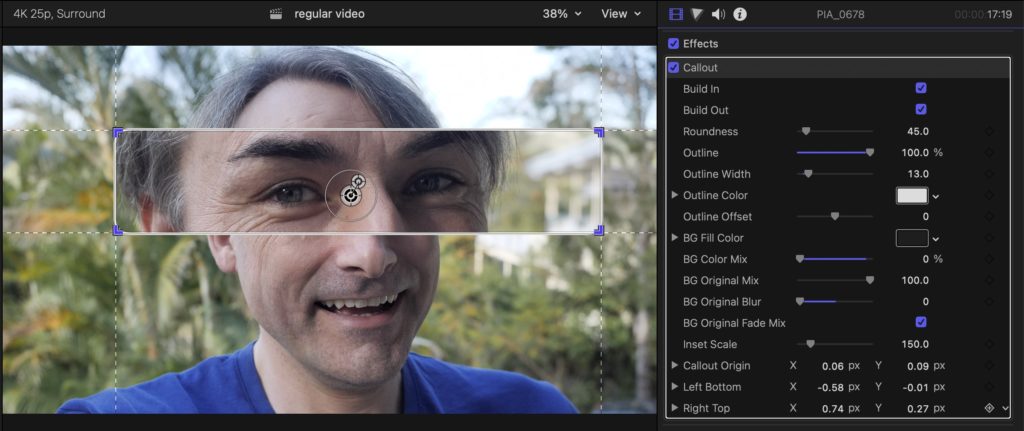Here on the Final Cut Pro Creative Summit, on the Developer Center simply throughout from Apple Park, we have been proven the most recent model of Final Cut Pro 11 for Mac in a slick, stay, in-person demo. After that, we trekked throughout to Apple Park itself to take a look at some stay demos and ask some difficult questions. In a primary, we have been allowed to take footage exterior Apple Park, and it’s as gorgeous a constructing as you could have thought.

Back to FCP. As properly because the 3D spatial video modifying help promised earlier this yr, plenty of extra options that editors will love are included, and essentially the most spectacular is the Magnetic Mask. Let’s take a tour by means of the brand new options in FCP 11. (There have been additionally new releases of Logic, FCP for iPad, and Final Cut Camera. Scott Simmons has additionally written a great article about these releases — test it out.)
Magnetic Mask
Over the previous few years, AI has actually stepped up, making tedious or unattainable jobs far much less arduous, and the brand new Magnetic Mask is a machine-learning-powered software that can win many followers. While chromakey stays the best resolution for eradicating an individual or object from a background, you’re not all the time in charge of the shoot or the shopper.
A few releases again, FCP added the Scene Removal Mask, which mixed a distinction masks with machine studying smarts to take away a set background, and third-party results like Keyper enabled automated “person tracking”. These options have been helpful, however typically lacked temporal stability, and Keyper might solely acknowledge folks.
Similar to the Rotobrush in After Effects and the Magic Mask in DaVinci Resolve, the brand new Magnetic Mask isolates a part of a shot, and is extra highly effective than beforehand included choices. To use it, drag the Magnetic Mask impact immediately onto an individual or an object in any shot, and its define shall be robotically acknowledged. Move the mouse just a little to shift the detected define, and if it’s nonetheless not proper, you should utilize brush instruments so as to add or subtract areas. When you’re pleased with this body, press Analyze and it’ll be tracked all through the shot — however this isn’t a set form like the prevailing object monitoring.

Instead, as the item modifications from body to border, the Magnetic Mask define modifications to match it, much like the Segment Anything Model beforehand introduced by Meta. An individual’s arms shifting as they stroll? No downside, they’ll be discovered and chosen in each body. What in the event that they stroll behind one thing, after which stroll out once more? Occlusion is properly dealt with, so there’s probability it’ll work completely. What if it is advisable to observe a number of folks directly? No downside, every choice shall be proven in a distinct coloration, and might even occlude each other.

It’s fast, it really works properly, and it’s the right resolution when a shopper asks to isolate any a part of a shot. The common workflow shall be to duplicate a shot above itself, silence the highest copy, then use Magnetic Mask to isolate a part of that high copy. Add no matter results it is advisable to the highest clip and/or the underside clip, and add another parts (like titles) between the 2 clips if you want.
There are included sliders to tweak the sides, however if you’d like a full suite of matte instruments, you must in all probability do that in Motion as an alternative — it’s bought this new impact and plenty of extra results for remaining tweaking. In FCP, it is a stable software that offers good outcomes, and may make it simple to focus on absolutely anything.
Automatic Captions
This is a characteristic that folks have been requesting for a very long time, and it’s lastly right here. Leveraging the help in macOS Sequoia, it’s now potential to create high-quality captions, offline, at no cost, in a short time certainly — choose any variety of clips, proper click on, then select Transcribe to Captions. If you wanted this already, you’ve in all probability been utilizing one thing like MacWhisper, or Descript, or Premiere Pro, or DaVinci Resolve, or Simon Says to create captions after which reimport them, however that is faster and simpler. (Note that that is English-only for now.) How good are the captions? Quality is sweet, however this mannequin appears much less more likely to guess at phrases it doesn’t fairly acknowledge than MacWhisper. If you see an ellipsis (…) that can typically point out an omission you must verify.

It’s necessary to notice that these captions are the nice sort of captions — closed captions. These are exported individually as an SRT file, are displayed on the viewer’s most well-liked dimension or will be hidden solely, robotically transfer out of the way in which when the playback bar seems, which assist accessibility and search engines like google, and which will be edited after the video is uploaded if a mistake is discovered. The unhealthy sort of captions are open captions: burned in titles, with fastened dimension and font, that may’t be turned off and which might be inaccessible. These are, nonetheless, the one technique to go if you happen to’re concentrating on platforms like Instagram and TikTookay that don’t help correct closed captions.
If it is advisable to create titles out of your closed captions, that’s not but in-built, and although there have been apps that provided this characteristic (together with Captionator and Transcriber) there’s a model new one which does an ideal job: captionAnimator, from Intelligent Assistance. Give it a timeline with closed captions and a single title of your selection (arrange simply the way in which you prefer it) and also you’ll obtain a brand new timeline stuffed with open captions to match.
Text-based modifying can be not but a part of the app, however I’ve been capable of mash collectively a brief resolution which works fairly properly. You’ll want CommandPublish, and the script on the finish of this text, which blades all timeline video at the beginning and finish of every caption. Paste it into the Snippet editor (Preferences > Scripting), choose the primary caption in your timeline, and hearth it up. Let me know in case you have any points.
Now, the Timeline Index exposes all of the captions, and you’ll click on on any caption to leap to it within the timeline. Press C, and also you’ll choose the video that matches it. Hit delete, and also you’ll take away the video and its caption. Without an excessive amount of effort, now you can shortly use textual content to each navigate a timeline and edit it, and it’ll definitely be helpful for some sorts of edits.
Spatial Video Editing
Please excuse my pleasure — I’ve had an Apple Vision Pro for a number of months now, and though it’s a beautiful gadget, it’s been a problem to create my very own content material for it. Workarounds did exist, however now they’re redundant: FCP 11 can import and edit Spatial clips from current iPhones (15 Pro, 15 Pro Max, any 16) or the Apple Vision Pro itself, after which export to Spatial utilizing a brand new vacation spot within the Share command. Distribution is sorted too, because of Vimeo’s current announcement of their Vision Pro app and help for Spatial movies.
If you’re not throughout the format, Spatial video is 3D stereoscopic video, utilizing the MV-HEVC codec, with metadata to explain the sector of view. It’s not 180° VR, however is rather more like a standard 3D film, and doesn’t require a wholesale change in the way in which you make your movies. Indeed, you may shoot in 3D, edit in FCP, after which ship to Spatial and conventional 2D from a single timeline. This ought to make experimenting with this format risk-free, so in case you have purchasers curious to strive it out, why not?

Under the hood, Spatial clips are handled as double-width clips with the left and proper eyes side-by-side at full dimension, and certainly, if you happen to have been to make use of one other app (comparable to Blender) to create clips on this FSBS format, you may deal with them similar to common Spatial clips if you happen to select the proper Stereoscopic setting within the Info Inspector. That’s glad information, as a result of it means editors can make the most of present 3D instruments with none additional work.
When working with Spatial clips, a brand new submenu within the Viewer referred to as “View Stereoscopic As” provides a number of methods to work. You can select to see only one eye, each eyes collectively, or an overlap of the 2 in Anaglyph, Superimpose or Difference mode. Yes, you may pop on a pair of purple/cyan glasses and work with that if you happen to like, although in fact it’s not the identical as working stay on the Vision Pro. Sadly, there’s no direct hyperlink to the Vision Pro but, although I anticipate it’s within the works.

In the Inspector, you’ll see a brand new setting group below Video that features a Convergence adjustment. This strikes a clip forwards or backwards in 3D house by adjusting the hole between the 2 eyes, and that is how you must place titles in 3D house. Negative convergence strikes away from the viewer, whereas constructive convergence strikes in the direction of the viewer. Be certain to make use of constructive convergence briefly, at low values, and sparingly, since you’ll be asking your viewers to go cross-eyed, and it’s uncomfortable.
Right now, it’s additionally just a little difficult to reframe, crop, rotate or scale spatial clips. The Transform controls are disabled by default, and if you happen to activate them, you’ll discover they management the digital double-width clip somewhat than every eye independently. This management is required for some technical duties, however if you’d like controls that alter each eyes collectively, there’s a simple workaround. Create a brand new impact in Motion that publishes all of the Transform properties (Position, Crop, Four-Corner) and now you may alter these properties for each eyes directly.

In future releases, I’d like to see built-in rework controls which do what most editors want, and in addition full 3D integration from Motion templates into FCP, however that is OK for now.
With regard to Spatial video, FCP isn’t alone; DaVinci Resolve introduced Spatial help earlier this week, and sooner or later shall be supporting 180° VR Immersive 3D for his or her upcoming URSA CINE Immersive digicam too. Still, as spectacular as 180° Immersive movies are, easy Spatial is a better approach into 3D for most people. It’s by no means been simpler for normal people to work in 3D video, and I can’t wait to see what we make.
Many smaller enhancements
Besides the brand new headline options, many smaller key instructions and extra minor updates spherical out the discharge. Support for 90/100/120fps timelines could be very welcome, permitting everybody to create media for immediately’s high-frame price shows. The new Vertical zoom-to-fit command (Option-Shift-Z) enhances the prevailing horizontal zoom-to-fit (Shift-Z) to maintain your timeline view organized. Commands already existed to pick the clip above or beneath the presently chosen clip (Command-up/down) nevertheless it’s now potential to transfer clips up and down within the stack too, with Option-up/down). If you’ve ever wrestled with particular vertical placement in a posh stack of related clips, you’ll now have a a lot simpler time.
Browser clips can now be hidden, not merely rejected — however why would you need to cover clips somewhat than delete them? Well, if you happen to’re utilizing multicam or sync workflows, the unique supply clips would usually stay seen after a multicam clip has been created, and also you in all probability by no means want to the touch these authentic clips once more. Now, they’re hidden by default, leaving the browser show a lot cleaner. Of course, you may reveal hidden clips if you want, or not cover them within the first place.
A brand new set of Modular transitions let you easily transfer from one shot to a different, pausing mid-transition to indicate each frames collectively in a break up display, with loads of choices. While I’d anticipate most editors to utilize a wise side-by-side or high/backside break up, there’s a Shapes choice there too. If you’ve been lacking a star wipe, right here’s an choice for you.

There are additionally two new results, Callout and Picture in Picture, which allow new, helpful methods to focus consideration on a part of the body, and provide on-screen controls and extra sliders to make them very customizable. Note that if you’d like Callout to happen part-way by means of a clip, you’ll have to blade the clip up and apply the impact to 1 section solely.

However, I do confess to considerably blended emotions right here, as a result of these results duplicate among the options of my very own plug-ins! Callout attracts consideration to a selected a part of the body, very similar to the Zoom In titles in my funwithstuff Annotator plug-in. Picture in Picture shrinks and crops a clip to a rectangle and provides a border, very similar to the Rectangles impact in my funwithstuff PiP Kit plug-in.

Now, I’m not claiming I’ve been “Sherlocked”; my plug-ins aren’t the one choices available on the market, they usually nonetheless provide many extra choices than the brand new defaults. Hopefully, if folks like these new results and need extra controls, they could search out and discover mine. But nonetheless, if you happen to see emoji-based particles like funwithstuff Emojisplosion in a future FCP launch, I’ll be suspicious. 😉
Blackmagic RAW help coming quickly
This was introduced nevertheless it’s not but accessible: because of the Media Extensions help in macOS Sequoia, Blackmagic shall be implementing help for Blackmagic RAW in Final Cut Pro. This is nice information, and we’ll remember to check this when it goes stay.
Final Cut Camera 1.1 can now do Log HEVC
If you need the standard of Log however would like to keep away from exterior SSDs, you could have chosen to go along with Kino or Blackmagic Camera, however now there’s an official Apple-made app that enables Log HEVC recording, with an ideal zoom management. You may select to preview your video with a LUT, and use the brand new tilt and roll indicators to stage your digicam in two dimensions.

The information price is low-ish (below 25Mbps for 4K) however I haven’t seen any points myself. If you want the next information price than that, Blackmagic Camera has a ton of choices, however Final Cut Camera has a clear UI that can win numerous followers.
Final Cut Pro for iPad 2.1
Several of the brand new options on the Mac have come throughout to the iPad. Magnetic Mask is right here, as are the brand new Modular transitions and the brand new Picture-in-Picture and Callout results and the upper timeline body price help. Enhance Light and Color has come throughout from the earlier Mac launch too, and a brand new pinch gesture permits vertical scaling within the timeline. The pencil help has expanded to incorporate extra brush choices, so that you’ll have extra choices for Live Drawing. Remember too that these drawings will be introduced again to the Mac model.
Either approach, if you happen to get pleasure from modifying in FCP for iPad, otherwise you choose to make use of it to handle a multicam shoot after which switch to Mac, it’s a stable app with real utility. It’s nice to see its updates proceed.
Logic 11.1
With the brand new launch for Mac and iPad, there are a number of new options. Here’s the full list, however the standout is the inclusion of the Quantec Room Simulator by Wolfgang “Wolf” Buchleitner. The stay demo we heard sounded nice, and it’s nice to see digital audio historical past being recreated. The replace is free, and you’ll roundtrip between Mac and iPad, so give it a shot.
Conclusion
This is a giant launch of FCP — severe small enhancements, model new options for everybody and a complete new dimension for courageous souls exploring the brand new frontier of 3D. Automatic captioning will deliver accessible captions for everybody who wants them, and allow text-based modifying too. Cheap and reasonably priced choices now exist for anybody who additionally must hard-code these captions as animated titles as properly.
Editing in 3D for the Apple Vision Pro simply bought a complete lot simpler, and whereas Spatial isn’t as breathtaking as 180° Immersive, it completely makes a tangible distinction, and it’s a lot, a lot simpler to shoot, edit and distribute. While we’re right here on the Final Cut Pro Creative Summit, I’ll be speaking about 3D, Spatial and Immersive video, and there are a lot of different talks available too. Right now, I have to get chatting and prep for my periods over the following two days. It’s an ideal convention, and this was a good way to kick off the primary day. Cheers!
Here’s the script for blading round captions:
native fcp = require("cp.apple.finalcutpro")
native simply = require("cp.just")
native eventtap = require("hs.eventtap")
-- Ensure Final Cut Pro is lively
fcp:launch()
-- Function to carry out the blade motion at the beginning and finish of a caption
native perform bladeCurrentCaption()
eventtap.keyStroke({"shift"}, "i") -- Go to start out of the caption
eventtap.keyStroke({"cmd", "shift"}, "b") -- Blade All at the beginning of the caption
eventtap.keyStroke({"shift"}, "o") -- Go to finish of the caption
eventtap.keyStroke({}, "right") -- Move one body ahead
eventtap.keyStroke({"cmd", "shift"}, "b") -- Blade All on the finish of the caption
finish
eventtap.keyStroke({"shift"}, "i") -- Go to start out of the caption
-- Track the playhead place to detect the tip of the timeline
native previousPlayheadPosition = fcp:timeline():playhead():place()
-- Loop to repeat the sequence till the playhead place stops altering
whereas true do
bladeCurrentCaption()
-- Move to the following caption
eventtap.keyStroke({"cmd"}, "right")
-- Check the brand new playhead place
native currentPlayheadPosition = fcp:timeline():playhead():place()
if currentPlayheadPosition == previousPlayheadPosition then
print("Reached the end of the timeline.")
break
finish
-- Update the earlier playhead place for the following iteration
previousPlayheadPosition = currentPlayheadPosition
finish















Leave a Reply